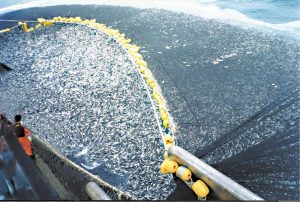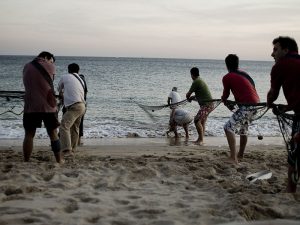Fish are Friends and Food: The rise of the US federal seafood certification
by RJD Intern Daniela Ferraro
As appetite increases, people are looking towards federally managed fisheries to provide a seafood certification system. With rising levels of overfishing, habitat destruction, and mismanagement, there has been an emphasis placed upon fishing regulations and sustainable fishing practices (Jackson et al 2001). This began with adjustments to the Magnuson-Stevens Fisheries Conservation and Management Act (MSA) in 2006, giving the National Marine Fisheries Service (NMFS) and Regional Fishery Management Councils permission to establish annual catch limits. Fishing limits are an attempt at keeping stocks from being overfished. Sustainable fishing is the process of maintaining a balance in favor of the number of fish reproduced versus stocks fished. Unfortunately, stocks are not rebuilding and continuing to decline in number (Rothschild et al).
The federal government’s jurisdiction reaches as far as the end of the Exclusive Economic Zone from 3 to 200 miles offshore. In the past 8 years, from 2007 to 2014, the federal government has worked to develop a framework for seafood import and certification as well as an eco-label program. These guidelines abide by the standards set in the MSA with input from eight of the Marine Fisheries Advisory Committee meetings (Sasser et al 2006). Currently, there are at least 200 consumer guides and 70 certifications and eco-labels that focus on wild caught fisheries and aquaculture. The largest certification program is the Marine Stewardship Council (MSC), which acts to align fisheries based on a specific set of standards that support sustainability. MSC’s guidelines take the status of the fishery, efficacy of management, and the impact to habitat into effect when assigning certifications (Christian C 2013). In developing countries, MSA has certified fishing fleets involved in fisheries improvement projects (FIPs) to encourage sustainability. While FIPs relay the means towards sustainable fishing, these fleets don’t meet MSA standards (Bush et al). Large corporations in the United States, such as McDonald’s and Walmart, along with the European Union recently agreed to buy only MSC-certified seafood (MSC 2013).
Opposition comes in the form of Senator Lisa Murkowski’s Responsible Seafood Certification and Labeling Act (S. 1521), a bill introduced on September 18, 2013. Murkowski proposes to prevent the federal government from granting contracts to third party certification seafood vendors, promoting a label based on criteria developed by a third party, and upholding standards that recommend third party seafood. This bill directly opposes third party seafood certifications. The National Marine Fisheries Service (NMFS) assisted MAFAC and NOAA in developing FishWatch, an agency dedicated to providing seafood consumers with information on federally managed fisheries (30). It competes with nongovernmental efforts by the Monterey Bay Aquarium and Blue Ocean Institute to “provide(s) easy-to-understand science-based facts to help consumers make smart sustainable seafood choices” (NMFS 2013). While still claiming neutrality, NMFS has taken a step towards federal certification and eco-labeling.
In attempt to reconcile a national fishing industry and local fisherman with third party certifiers, NMFS has space to be the go-between and resolve conflict. In creating its own labeling and certification program, NMFS will serve as an advocate for fishermen in an economy that serves the consumer over seafood sustainability. The necessity and demand for a federally-managed certification program deals with issues such as market, fisheries, and communication. A reinforcing of existing structure coincides with the thought that third-party organizations and their certifications are methods of privatizing governance. MAFAC and NMFS tackle not only the definitions of sustainable fisheries but issues of control and who should have the authority to claim sustainability. In the future, fishery certification and eco-labeling could become the next wave of categorizing seafood, with “sustainable” sitting right alongside “organic” and the Organic Foods Protection Act (Stoll et al. 2014).
References
Bush S, Toonen H, Oosterveer P, Mol A. The ‘devils triangle’ of MSC certification: balancing credibility, accessibility and continuous improvement. Mar Policy 2013l 3:288-93
Christian C, et al. A review of formal objections to Marine Stewardship Council fisheries certifications. Biol Conserv 2013; 161: 10-7
Jackson J, et al. Historical overfishing and the recent collapse of coastal ecosystems. Science 2001; 293 (5530): 629-37
Marine Stewardship Council (MSC). McDonald’s first USa national restaurant chain to serve MSC certified sustainable seafood to all US locations. 2013b
National Marine Fisheries Service (NMFS). FishWatch. 2013
Rothschild B, Keiley E, Jiao Y. Failure to eliminate overfishing and attain optimum yield in the New England groundfish fishery. ICES J Mar Sci: J du Cons 2013:fst118
Sasser E, Prakash A, Cashore B, Auld G. Direct targeting as an NGO political strategy: examining private authority regimes in the forestry sector. Bus Polit 2006; 8(no. 3): 1-32
Stoll J, Johnson T. Under the banner of sustainability: The politics and prose of an emerging US federal seafood certification. Mar Pol 51 2015: 415-422





